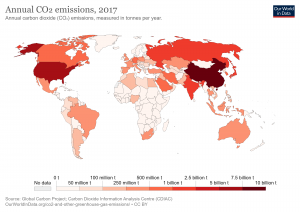The unique powers of quantum computation may give humanity an important weapon — or several weapons — against climate change, according to one quantum computer pioneer.
One of the possible solutions for the excess carbon in the atmosphere and to reach global climate goals is to suck it out. It sounds pretty easy, but, in fact, the technology to do so cheaply and easily isn’t quite here yet, according to Jeremy O’Brien Chief Executive Officer, PsiQuantum, a quantum computing startup.
Currently, there is no way to simulate large complex molecules, like carbon dioxide. Current classical computers cannot simulate these types of molecules because the problem grows exponentially with the size or complexity of the simulated molecules, according to O’Brien, who wrote an article outlining the issue at the World Economic Forum’s annual meeting held recently.
“Crudely speaking, if simulating a molecule with 10 atoms takes a minute, a molecule with 11 takes two minutes, one with 12 atoms takes four minutes and so on,” he writes. “This exponential scaling quickly renders a traditional computer useless: simulating a molecule with just 70 atoms would take longer than the lifetime of the universe (13 billion years).”

Quantum computers could come to our rescue, added O’Brien. As far back as 1981, Physicist Richard Feynman recognized that quantum computers could perform calculations that would be impossible for classical computers, particularly when it comes to simulating molecules. Microsoft and others have concrete recipes for performing these simulations.
Although CO2 is captured naturally, by oceans and trees, CO2 production has exceeded these natural capture rates for many decades. A catalyst for scrubbing carbon dioxide directly from the atmosphere could be a powerful tool in tackling climate change. Creating those catalysts, though, requires a better understanding of materials science. Most known catalysts contain expensive precious metals or are difficult or expensive to produce and/or deploy.
“While we can’t literally turn back time, [it] is a bit like rewinding the emissions clock,” according to Torben Daeneke at RMIT University.
According to O’Brien, given the infinite number of chemical candidates that are available, experts are optimistic that there is a potential catalyst — or many potential catalysts — that will do the job cheaply and easily. Finding such a catalyst, however, is a daunting task without the ability to simulate the properties of candidate molecules. And that’s where quantum computing could help.
“While we can’t literally turn back time, it is a bit like rewinding the emissions clock,” –Torben Daeneke, RMIT University.
Quantum Computers to the Rescue
A quantum computers’ ability to simulate molecular models makes it a natural tool for finding those catalysts. But, they’re not ready yet.
“We can currently simulate small molecules on prototype quantum computers with up to a few dozen qubits (the quantum equivalent of classical computer bits),” he writes. “But scaling this to useful tasks, like discovering new CO2 catalysts, will require error correction and simulation to the order of 1 million qubits. It’s a challenge I have long believed will only be met on any human timescale — certainly by the 2030 target for the SDGs — if we use the existing manufacturing capability of the silicon chip industry.”
O’Brien said that it’s not just chemicals in the atmosphere that quantum computers could help us unravel. We could use this power to simulate existing important molecules that we find and use in nature –- including within our own body -– and thereby understand their behavior. There is also an infinite number of new molecules that could be designed for new applications, O’Brien adds.
“We might even find a cheap catalyst that enables efficient carbon dioxide recycling and produces useful by-products like hydrogen (a fuel) or carbon monoxide (a common source material in the chemical industry),” O’Brien writes.

In fact, quantum simulation could be hugely valuable is in meeting many of the council’s SDGs — Sustainable Development Goals — not only in health, energy, industry, innovation and infrastructure but also in climate action, according to O’Brien. Examples include room-temperature superconductors (that could reduce the 10% of energy production lost in transmission), more efficient processes to produce nitrogen-based fertilizers that feed the world’s population and new, far more efficient batteries. One very powerful application of molecular simulation is in the design of new catalysts that speed up chemical reactions. It is estimated that 90% of all commercially produced chemical products involve catalysts, in living systems, they’re called enzymes.
Next Steps
At a recent meeting of the World Economic Forum’s Global Future Councils a team of experts from across industry, academia and beyond met to discuss how quantum computing can help address global challenges, as highlighted by the SDGs, and climate in particular.
O’Brien said the meeting offered him hope and intriguing possibilities.
“As co-chair of the Global Future Council on Quantum Computing, I was excited that we were unanimous in agreeing that the world should devote more resources, including in education, to developing the powerful quantum computing capability that could help tackle climate change, meet the SDGs more widely and much more,” he writes. “We enthusiastically called for more international cooperation to develop this important technology on the 2030 timescale to have an impact on delivering the SDGs, in particular climate. So the real question for me is: can we do it in time? Will we make sufficiently powerful quantum computers on that timeframe? I believe so. There are, of course, many other things we can and should do to tackle climate change, but developing large-scale, error-corrected quantum computers is a hedge we cannot afford to go without.”

















